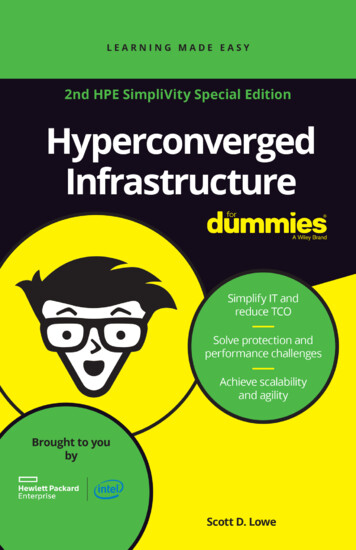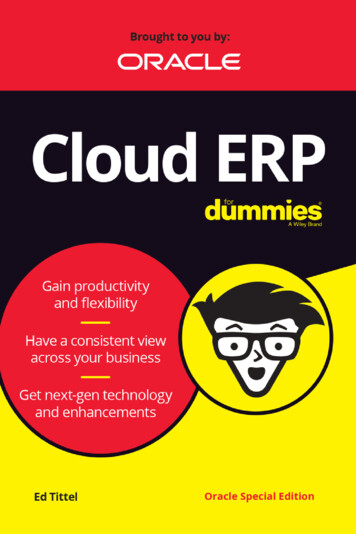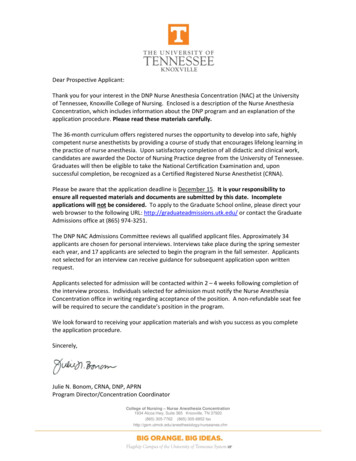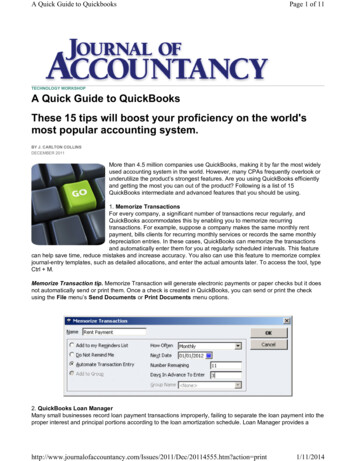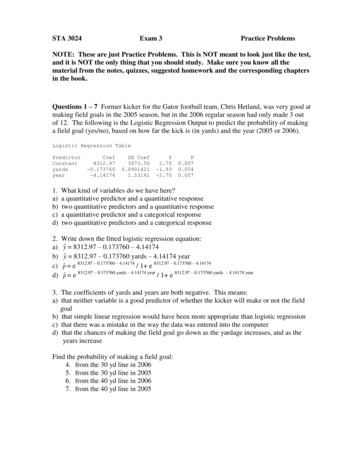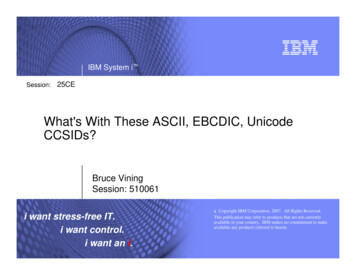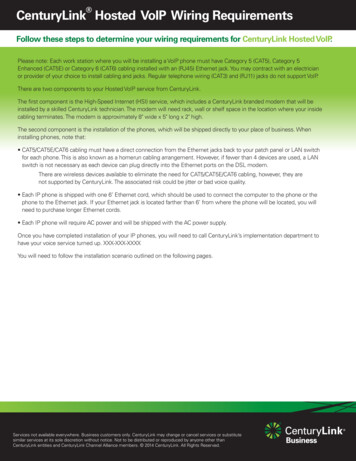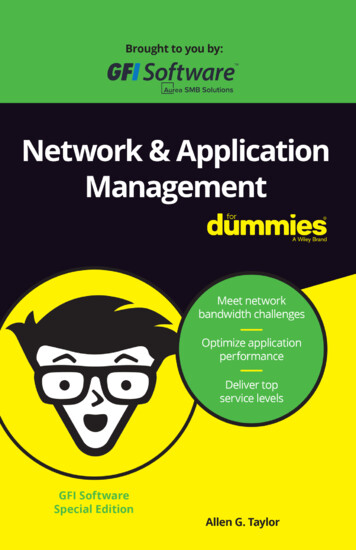
Transcription
These materials are 2020 John Wiley & Sons, Inc. Any dissemination, distribution, or unauthorized use is strictly prohibited.
Network &ApplicationManagementGFI Software Special Editionby Allen G. TaylorThese materials are 2020 John Wiley & Sons, Inc. Any dissemination, distribution, or unauthorized use is strictly prohibited.
Network & Application Management For Dummies ,GFI Software Special EditionPublished byJohn Wiley & Sons, Inc.111 River St.Hoboken, NJ 07030-5774www.wiley.comCopyright 2020 by John Wiley & Sons, Inc., Hoboken, New JerseyNo part of this publication may be reproduced, stored in a retrieval system or transmitted in anyform or by any means, electronic, mechanical, photocopying, recording, scanning or otherwise,except as permitted under Sections 107 or 108 of the 1976 United States Copyright Act, withoutthe prior written permission of the Publisher. Requests to the Publisher for permission should beaddressed to the Permissions Department, John Wiley & Sons, Inc., 111 River Street, Hoboken, NJ07030, (201) 748-6011, fax (201) 748-6008, or online at http://www.wiley.com/go/permissions.Trademarks: Wiley, For Dummies, the Dummies Man logo, Dummies.com, and related trade dressare trademarks or registered trademarks of John Wiley & Sons, Inc. and/or its affiliates in theUnited States and other countries, and may not be used without written permission. GFI and theGFI logo are trademarks or registered trademarks of GFI Software. All other trademarks are theproperty of their respective owners. John Wiley & Sons, Inc., is not associated with any product orvendor mentioned in this book.LIMIT OF LIABILITY/DISCLAIMER OF WARRANTY: THE PUBLISHER AND THE AUTHOR MAKE NOREPRESENTATIONS OR WARRANTIES WITH RESPECT TO THE ACCURACY OR COMPLETENESS OFTHE CONTENTS OF THIS WORK AND SPECIFICALLY DISCLAIM ALL WARRANTIES, INCLUDINGWITHOUT LIMITATION WARRANTIES OF FITNESS FOR A PARTICULAR PURPOSE. NO WARRANTYMAY BE CREATED OR EXTENDED BY SALES OR PROMOTIONAL MATERIALS. THE ADVICEAND STRATEGIES CONTAINED HEREIN MAY NOT BE SUITABLE FOR EVERY SITUATION. THISWORK IS SOLD WITH THE UNDERSTANDING THAT THE PUBLISHER IS NOT ENGAGED INRENDERING LEGAL, ACCOUNTING, OR OTHER PROFESSIONAL SERVICES. IF PROFESSIONALASSISTANCE IS REQUIRED, THE SERVICES OF A COMPETENT PROFESSIONAL PERSON SHOULD BESOUGHT. NEITHER THE PUBLISHER NOR THE AUTHOR SHALL BE LIABLE FOR DAMAGES ARISINGHEREFROM. THE FACT THAT AN ORGANIZATION OR WEBSITE IS REFERRED TO IN THIS WORKAS A CITATION AND/OR A POTENTIAL SOURCE OF FURTHER INFORMATION DOES NOT MEANTHAT THE AUTHOR OR THE PUBLISHER ENDORSES THE INFORMATION THE ORGANIZATIONOR WEBSITE MAY PROVIDE OR RECOMMENDATIONS IT MAY MAKE. FURTHER, READERSSHOULD BE AWARE THAT INTERNET WEBSITES LISTED IN THIS WORK MAY HAVE CHANGED ORDISAPPEARED BETWEEN WHEN THIS WORK WAS WRITTEN AND WHEN IT IS READ.For general information on our other products and services, or how to create a custom For Dummiesbook for your business or organization, please contact our Business Development Department inthe U.S. at 877-409-4177, contact info@dummies.biz, or visit www.wiley.com/go/custompub.For information about licensing the For Dummies brand for products or services, contactBrandedRights&Licenses@Wiley.com.ISBN 978-1-119-62410-3 (pbk); ISBN 978-1-119-62411-0 (ebk)Manufactured in the United States of America10 9 8 7 6 5 4 3 2 1Publisher’s AcknowledgmentsWe’re proud of this book and of the people who worked on it. Some of thepeople who helped bring this book to market include the following:Project Editor: Martin V. MinnerEditorial Manager: Rev MengleAcquisitions Editor: Ashley CoffeyBusiness DevelopmentRepresentative: Molly DaughertyProduction Editor:Tamilmani VaradharajThese materials are 2020 John Wiley & Sons, Inc. Any dissemination, distribution, or unauthorized use is strictly prohibited.
Table of ContentsINTRODUCTION. 1CHAPTER 1:Understanding Networks and Applications. 3Exploring Networks. 3Small networks. 4Medium networks. 4Large networks. 4Understanding What an Application Is. 5Critical apps. 5Other useful apps. 5Unsanctioned apps. 6Recognizing That the App Is King. 6Setting priorities. 6Safeguarding critical apps. 7Adapting to network changes. 8Visualizing app execution. 8CHAPTER 2:Surveying a Constantly Evolving Landscape. 9Comparing Networks of Past and Present. 9Looking at App Evolution. 10Seeing That the Cloud Adds Complexity. 11Dealing with Unsanctioned Apps. 11CHAPTER 3:Understanding That DifferentStakeholders Have Different Concerns. 13Addressing End-Users’ Quality of Experience. 14Slow or unresponsive apps. 14Apps unavailable when you want them. 15Caring About Effective Use of Apps and Personnel. 15Users not using apps effectively. 15Moving data to the cloud can have unintendedconsequences. 16Keeping Customers Happy and Staying on Budget. 16The same user operational problems keep occurring. 17No visibility of the source of problems. 17Table of ContentsiiiThese materials are 2020 John Wiley & Sons, Inc. Any dissemination, distribution, or unauthorized use is strictly prohibited.
Problems consume staff time, leaving none forrequired maintenance. 17Disconnect with business management overcloud usage. 18CHAPTER 4:Solving Problems. 19Using Apps Effectively. 19Maintaining Productivity by Keeping Apps Functioning. 20Being Proactive: Staying Ahead of the Curve. 21CHAPTER 5:Identifying Problems. 23Identifying What Is Causing the Problem. 23Coping with Unsanctioned Apps. 24Dealing with Bring-Your-Own-Device. 25Protecting against Users Bypassing Your Safeguards. 25CHAPTER 6:Looking for Solutions. 27Depending on the Firewall. 27Throwing Bandwidth at the Problem. 27Employing Filters. 28Managing a Software-Defined WAN. 28Applying QoS Management to Applications. 29CHAPTER 7:Finding a Better Way. 31Providing Visibility across the Network. 32Managing Bandwidth. 33Employing a Recommendation Engine. 33Generating Detailed Reports. 34Monitoring in Real Time. 35Having a Single Tool That Monitors and Manages. 35Gaining Productivity with an Easy-to-Understand Interface. 35CHAPTER 8:Working with Advanced Networkand Application Management. 37Setting Policy Dynamically. 37Employing a Solution Center. 38Placing Users into Priority Groups. 39Allotting Users’ Resource Quotas. 40Centrally Managing Multiple Locations. 40CHAPTER 9:ivTen Points to Remember. 41Network & Application Management For Dummies, GFI Software Special EditionThese materials are 2020 John Wiley & Sons, Inc. Any dissemination, distribution, or unauthorized use is strictly prohibited.
IntroductionManaging a network and the applications that run on it isa demanding job. To keep things running smoothly andprovide the level of service that users and the organization expect, network managers need tools that can help themmeet those expectations.About This BookNetwork Application & Management For Dummies, GFI SoftwareSpecial Edition, looks at the challenges that network manag ers face, some of the tactics that managers use to meet those challenges, and some of the reasons why those tactics often don’tproduce the desired result. This book also describes a solutionthat can help you deliver the level of service your users need, at areasonable cost.Dummies books don’t require you to begin with Chapter 1 andread straight through to the end. You’re welcome to choose thechapters that interest you. Of course, you’re free to read the chapters sequentially if that’s what you prefer.Foolish AssumptionsIn this book, I assume that you, the reader, fall into one of threecategories:»» You’re responsible for a data center, and you are running upagainst capacity limits.»» You’re a C-level executive and your data center is of strategicand fiscal importance to your organization.»» You’re curious about how the operation of an organization’snetwork might be optimized.Introduction1These materials are 2020 John Wiley & Sons, Inc. Any dissemination, distribution, or unauthorized use is strictly prohibited.
Icons Used in This BookThe little pictures in the margins of this book indicate information that deserves your special attention. Watch for these icons:The Remember icon identifies important information that isworth committing to memory.The Tip icon indicates helpful insights and bits of knowledge thatmay make your job easier.2Network & Application Management For Dummies, GFI Software Special EditionThese materials are 2020 John Wiley & Sons, Inc. Any dissemination, distribution, or unauthorized use is strictly prohibited.
IN THIS CHAPTER»» Exploring networks»» Understanding what an application is»» Recognizing that the app is kingChapter1Understanding Networksand ApplicationsAmajor breakthrough in information technology took placein 1981 with the advent of the IBM PC. Where previously anenterprise might have used one room-filling, expensivemainframe computer, inexpensive personal computers proliferated and took over many of the jobs done by mainframes. Whereasa mainframe could be connected directly to resources such asstorage and printers, multiple PCs now needed access to thoseresources. Networks developed to connect multiple PCs to sharedresources. This was the origin of the local area network (LAN).Exploring NetworksThe word network is used in a variety of ways in a variety of contexts. In computing, a network is a system containing a combination of computers, peripheral devices, and telecommunicationequipment or cables that tie these things together. Networkingcomputers enables them to share resources and perform theirtasks more efficiently than would be possible if each computerstood alone.CHAPTER 1 Understanding Networks and Applications3These materials are 2020 John Wiley & Sons, Inc. Any dissemination, distribution, or unauthorized use is strictly prohibited.
Small networksNetworks come in all sizes, from a server and a few workstationsoperated by a mom-and-pop business to an enterprise-wide network that supports hundreds of thousands of workers. Any organization with a small network likely doesn’t need to worry aboutsupporting hundreds of thousands of users, but efficient management of even a small network is important. As the organizationgrows, the ability to grow the scale of the network to match thegrowth in workload is equally important.Network management relies on the ability to monitor, on a realtime basis, what is going on with the hardware, the applications, and the users. Performance issues must be identified andaddressed before they start to affect productivity. Visibility ofperformance issues is a necessary first step in network optimization. After a problem has been identified, the next step is toconfigure a traffic policy that will assure that the most importanttasks always have the bandwidth that they need.A small office network may have on the order of a hundred objectsor users. Available bandwidth must be such that those users cando their work without delays caused by bandwidth limitations,low-priority resource-hogging apps, or users who are usingresources inefficiently.Medium networksA medium-sized office network may need to support thousandsor tens of thousands of users. This requires considerably morethroughput capability than the small office network case. It alsoneeds to be scalable because networks that have reached this sizemay grow even larger, becoming even more demanding of systemresources.Large networksLarge networks are those with hundreds of thousands of elementsand users, potentially spread all around the world. For such a system, the productivity impacts of network inefficiencies are greatlyamplified. With large networks, the need to monitor the networkon a fine-grained level, to diagnose the causes of problems, andto allocate resources to users, applications, and groups, basedon their value to the organization, are all critically important.Equally important is the ability to maintain consistency acrossthe network in traffic policy.4Network & Application Management For Dummies, GFI Software Special EditionThese materials are 2020 John Wiley & Sons, Inc. Any dissemination, distribution, or unauthorized use is strictly prohibited.
Understanding What an Application IsThe purpose of having a network is so that applications canshare and be shared: communicating with each other, accessingcommon data, as well as distributing and aggregating actions.Applications are software programs that perform tasks intendedto accomplish useful work for the organization. Some applications are more important than others, and thus deserve a largershare of network resources. Applications may also have different requirements for network resources and quality of service.Voice over IP may not consume a lot of bandwidth but it demandslow-to-no latency in order to be effective.Critical appsCritical apps are those that your organization depends upon for itsnormal operation. These apps must run smoothly and predictably whenever they are needed. Whatever resources they requiremust always be available to them. What qualifies as a critical appvaries from one organization to another, but whatever it is, organizational efficiency depends heavily on its timely execution. If,for any reason, execution of a critical app is slowed to the pointwhere it interferes with the timely completion of important tasks,something must be done to correct the situation.Some examples of common critical applications on networksare Office 365 or anything that has voice communications — forexample, video/audio conferencing such as Zoom or Skype forbusiness, or Voice over IP.These are common critical apps requiring stringent SLAs(service-level agreements) to manage. Other examples are business backbone enterprise resource planning (ERP) systems suchas finance or human resources applications. Educational institutions may rely on e-learning systems that record student actionsand engagement, or administer timed examinations.Other useful appsMany applications and software tools, although not consideredto be critical apps, are valuable contributors to the success of theorganization. If they run a little slower than usual, organizational operations are not significantly handicapped. Valuable asthese apps are, if they contend with critical apps for bandwidth orother system resources, the critical apps should get more of thoseCHAPTER 1 Understanding Networks and Applications5These materials are 2020 John Wiley & Sons, Inc. Any dissemination, distribution, or unauthorized use is strictly prohibited.
resources and the useful but lower-priority apps should receiveless — perhaps much less, depending on the useful app’s value tothe organization.The network manager should be able to allocate bandwidthresources to applications depending on their value to the organization, as well as change allocations and network resource attributes to match organizational priorities.Unsanctioned appsIn addition to the critical apps and the other useful apps that aresupported by the IT department, users often install apps that theIT department has no control over. Some of these apps are innocuous and have a minor effect on system resources. Others can bemajor bandwidth hogs. Even worse, some such apps may represent a security risk, providing an entryway for malware into thenetwork. These are the apps that keep network administrators upat night.Network administrators should be able to detect and monitor theoperation of unsanctioned apps, and to reduce or eliminate theirimpact on the system if they become a problem.Recognizing That the App Is KingUltimately, the purpose of a computer network is to enable application communications among users and data. Consequently,nothing is more important than that applications run as quicklyand as problem-free as possible. Some apps are more importantthan others, so perhaps it is more correct to say that critical appsare kings and queens, other useful apps are dukes and duchesses,and unsanctioned apps are commoners.Setting prioritiesIn order to make sure that the most important jobs get done ina timely manner, priorities should be assigned to all apps thatutilize the network. These priorities should reflect each app’simportance to the organization. An app’s importance may varywith time, so it is important that priorities can be dynamicallyaltered on the basis of changing demands.6Network & Application Management For Dummies, GFI Software Special EditionThese materials are 2020 John Wiley & Sons, Inc. Any dissemination, distribution, or unauthorized use is strictly prohibited.
Critical apps should have a higher priority than merely usefulapps, and in turn, those apps should have a higher priority thanunsanctioned apps. However, it is often important to have controlof priorities that i
anaging a network and the applications that run on it is a demanding job. To keep things running smoothly and provide the level of service that users and the organiza-tion expect, network managers need tools that can help them meet those expectations. About This Book Network Application &a
